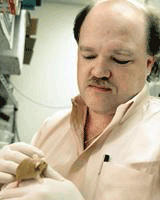 Associate Professor of Genetics
Associate Professor of Genetics
Director, Analytical Genomics and Transgenics Core
| Address: | Kaul Building, room 602 UAB Birmingham, AL 35294 |
| Telephone: | (205) 934-7206 |
| Email: | kesterso@uab.edu |
| Publications |
__________________________________________________________
Education
B.Sc. (Chemistry), Hendrix College
Ph.D. (Cell Biology), Baylor College of Medicine
Postdoctoral Studies (Neuroendocrinology), The Vollum Institute for Advanced Biomedical Research, Portland, Oregon
Research Interests
The main goal of Dr. Kesterson’s research is to define the mechanisms and neural pathways by which CNS melanocortin receptors regulate the feeding, energy balance, thermoregulation, inflammation, and learning and memory. Disruption of CNS melanocortin signaling due to loss of function mutations in the POMC gene (which makes the ligand a-MSH) or the type 4 melanocortin receptor (MC4R) produces obesity in humans and other mammals. Several approaches are currently being utilized to define the location of the neural circuitry by which a-MSH, MC4R, and MC3R (a related receptor involved with maintaining energy balance) function, including: creating conditional melanocortin receptor knockout animals using the cre/loxP recombinase system, developing transgenic mice expressing GFP, LacZ, and luciferase reporter transgenes to functionally map basal and brain-specific enhancer elements, and using microarray analyses and Real-Time RT-PCR to characterize changes in gene expression due to weight gain stemming from atypical antipsychotic medications (AAPDs). Dr. Kesterson also is working with a group of investigators to establish a mouse model for reconstituting human hematopoietic systems. To this end, double-knockout mice lacking Recombination Activating Gene (RAG) and the IL-2 receptor common g chain (gc) genes (which are unable to develop B, T or NK cells to mount a response to human cells) are being replenished with human CD34+ hematopoietic stem cells from cord blood or from GM-CSF-mobilized CD34+ peripheral blood cells from adult patients. Directors of the Flow Cytometry and High Speed Cell Sorting facility, and the Hematopoietic Stem Cell facility have pooled their expertise to establish this unique animal model.